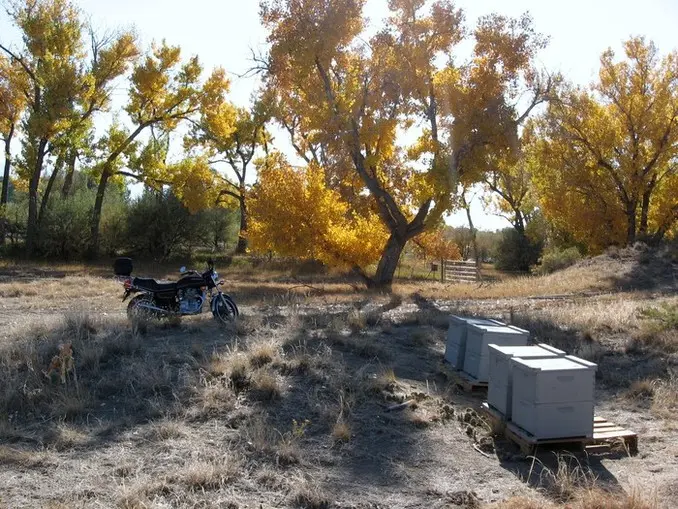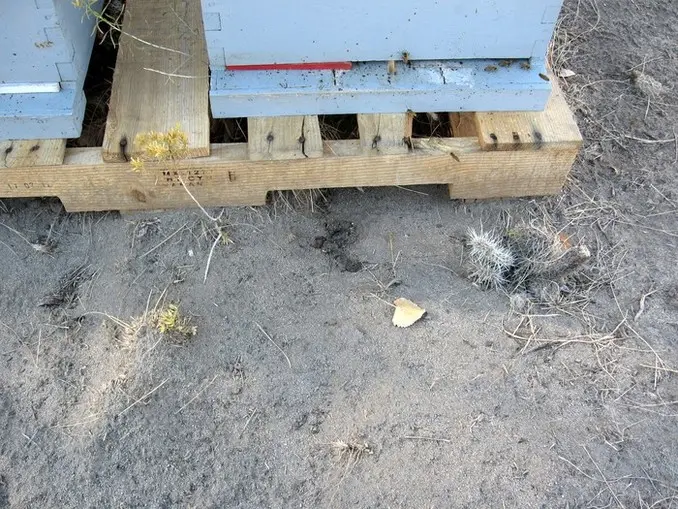Year 5 September - Embracing the Autumn Buzz 🖊️

-The sun shines on a gorgeous September day, the perfect time for a bike ride out to the beeyard.
A September Symphony - Biking to the Beeyard on a Beautiful Day
As the days remain warm to hot, the nights usher in a crisp coolness as the mountain air flows down the canyons. In these temperatures, any low-lying area risks a hard freeze. For my taste, it’s the pinnacle of the year. A blend of hot sun and chilly air.
Presently:
- Native bee forage is scarce.
- Agricultural areas are drying up.
- City bees, however, can still hustle for a living.
- It’s the final peek into the hives.
- Skunks continue their assault on the hives.
- Yard rent needs settling.
- A visit to the landowner awaits.
Forage
There’s a scarcity of native plants offering bee forage now:
- Gumweed has vanished.
- Rabbitbrush is on the wane.
- A handful of lingering sunflowers yield some pollen.
In agricultural spaces, alfalfa occasionally produces nectar in a few sheltered patches too short to cut. But the temperatures are too chilly for any significant flow.
Bees thrive better near town, where they’re still hustling. But that changes by month’s end. Bees spend their final flying hours seeking anything sweet.
Last Inspection
I had grand plans to:
- Rearrange some frames.
- Top off the division board feeders with sugar.
- Check the brood.
- Conduct mite counts.
- Trim entrances.
- Secure the lids for winter.
However, upon cracking open the hives:
- The bees were docile.
- They were still thriving.
- Minimal sugar consumption.
- No crawlers.
- No mite evidence.
- Hefty for winter.
So, I sealed them up and added entrance reducers.
No reason to disturb them. The bees can patch up any air leaks I’ve created. They’re in stellar shape, so it’s time to let them be.
I’ll swing by later to wrap the hives for wind protection when it’s too cold for bee flights. The hives will be tipped forward by blocking up the back of the hive or pallet.
That concludes this season and the monthly yard reports for a while.
Skunks vs. Cactus

-Skunks have replaced the cactus deterrent with their diggings and bee-filled scat.
The skunks have undoubtedly claimed victory. The cactus, strategically placed in front of the hives, has vanished. Only a few small plants linger.
But, aside from a couple of natural cactus plants, the path to these hives is now barren. Where did the cactus disappear to? Did it hitch a ride on a critter’s hide? Hard to tell.
The skunks are seizing the opportunity.
In the past, I might have taken action against them. But not now. The drought hit hard on all fronts. The skunks are merely trying to survive. Once the cold sets in, they pose no threat to the bees.
Next year, I’m experimenting with upper entrances using migratory covers. Commercial beekeeping experiences with inadvertent upper entrances weren’t pleasant, but I’ll give it a shot if it keeps the skunks at bay.
Any ingenious skunk-proofing ideas?
Landowner
Visiting the Durnells, the landowners of my beeyard, is always a pleasure. Reflecting on it, Burt and Betty have warmly welcomed me and the bees onto their land for two decades. Over that time, we’ve shared and witnessed numerous changes:
- My children grew up.
- The city encroached.
- We all grew a bit older.
- Floods and droughts.
- Moments of illness and joy.
- The soothing coolness of the river breaking the summer’s heat.
- The aroma of Burt’s wood-burning stove on a winter day.
Regrettably, Burt is no longer with us.
Staying rooted in one location for so long in beekeeping is a rarity. Most yard locations last only a few years. Once a remote area becomes accessible, owners and especially their adult children discover its charm. Before you know it, a new house stands where the bees once buzzed, and it’s time to relocate.
But not with the Durnells. They’re extraordinary people. ✨
-Cheers, D 🍂🐝
